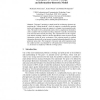148 search results - page 27 / 30 » The evolutionary capacity of protein structures |
GECCO
2004
Springer
14 years 2 days ago
2004
Springer
Aligning multiple DNA or protein sequences is a fundamental step in the analyses of phylogeny, homology and molecular structure. Heuristic algorithms are applied because optimal mu...
ECAL
2007
Springer
14 years 26 days ago
2007
Springer
This paper1 introduces a simple model for evolutionary dynamics approaching the “coding threshold”, where the capacity to symbolically represent nucleic acid sequences emerges ...
BMCBI
2004
13 years 6 months ago
2004
Background: Multiple sequence alignment algorithms are very important tools in molecular biology today. Accurate alignment of proteins is central to several areas such as homology...
BMCBI
2006
13 years 6 months ago
2006
Background: Quantitative descriptions of amino acid similarity, expressed as probabilistic models of evolutionary interchangeability, are central to many mainstream bioinformatic ...
BMCBI
2005
13 years 6 months ago
2005
Background: In a previous report (La et al., Proteins, 2005), we have demonstrated that the identification of phylogenetic motifs, protein sequence fragments conserving the overal...

